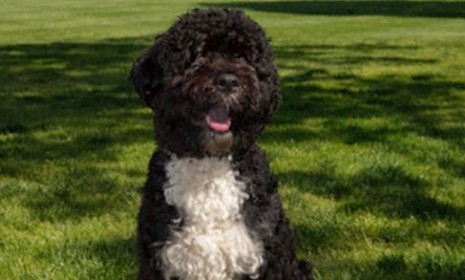Bella, Cha Cha Man, Boogles, Fido, Mopsulus: Dog-naming trends through the ages
Forget naming your pup Max. Pets in the middle ages were named things like Zaphyro and Smylfeste



2012: Bye bye, Max. Hello, Bella!
According to the yearly roundup of popular pet names in the database of Veterinary Pet Insurance, the 10 most popular dog names for 2012 were Bella, Bailey, Max, Lucy, Molly, Buddy, Daisy, Maggie, Charlie, and Sophie. It was the third straight year Bella came in at number 1, after unseating Max in 2009. A company spokesman thought the ascendancy of Bella might have had to do with "the name of the heroine in a certain vampire book/film series that's pretty popular these days."
2008: Sorry, Jake and Rocky — here come Chloe and Sophie
The Week
Escape your echo chamber. Get the facts behind the news, plus analysis from multiple perspectives.

Sign up for The Week's Free Newsletters
From our morning news briefing to a weekly Good News Newsletter, get the best of The Week delivered directly to your inbox.
From our morning news briefing to a weekly Good News Newsletter, get the best of The Week delivered directly to your inbox.
The year before Max lost the top spot, Jake and Rocky dropped off the top 10, replaced by newcomers Chloe and Sophie. Is there an "end of men" situation happening in the canine world too? Someone get the trend piece writers on that!
1985: Nipper is now George
In 1985, New York Times columnist William Safire asked readers to submit stories of how they named their dogs, and in return got a list of more than 12,000 dog names from all over the country. He noted a few trends. People tended to name their dogs after food (Cookie, Candy, Taffy, Peaches), disposition (Rascal, Bandit, Crab), color (Blackie, Amber, Midnight), and owner occupation ("Lawyers like Shyster and Escrow; doctors prefer Bones.") But the most noticeable trend was that people were using human names for their dogs more than they used to: "Instead of turning verbs and adjectives into proper nouns (for example, by calling a puppy that likes to nip your finger Nipper), we are using proper nouns directly, calling the little nipper George, Daisy, or Charley."
1960s-1980s: Getting gender specific
A free daily email with the biggest news stories of the day – and the best features from TheWeek.com
Anthropologist Stanley Brandes published a 2009 study of pet name trends as revealed by the gravestones at Hartsdale, America's first pet cemetery, just outside New York City. He noticed the trend toward human names for pets develop slowly from the 1960s to the 1980s when names like Riko, Ginny, Francois, Samantha, Daniel and Venus started to pop up among names like Freckles, Snowy, Clover, Spaghetti, Champ, Happy, Rusty and Taka. One consequence of this shift was that names started to entail information about the sex of the animal. This was not merely a consequence of a switch to human naming, though. Even non-human names started to show sex distinctions. Note, for example, the graves of Cha Cha Man, Candy Girl, Mr. Cat, and Dot-Z-Girl.
1896-WWII: Hobo, Jaba, Boogles
Hartsdale was established in 1896. Brandes notes that in the earliest monuments, the names of the pets might not even appear at all. Many of the early graves leave it at "Pets" or "My Pet." The family name of the owner is sometimes the only identifier. A well-known dancer of the time, Irene Castle, buried five dogs and a pet monkey under a monument engraved simply "Castle." Most of the graves do show pet names, but before WWII, they are almost never human names. The first half century at Hartsdale is represented by the likes of Brownie, Laddie, Hobo, Trixie, Rags, Jaba, Bunty, Boogles, Teko, Dicksie, Snap, Punch, Bébé and Pippy.
1800s: Semper Fido
Abraham Lincoln had a dog named Fido, and this is often cited as the reason the name became the quintessential dog's name, but Fido was popular before Lincoln even became president. A favorite children's book of 1845 was called "Fido or the Faithful Friend," and told of the quintessential adventures of the quintessential boy and his dog. It's rather too bad presidents' dogs aren't the source of lasting naming fashions. We could be calling our dogs Sweetlips, Scentwell, Vulcan, Drunkard, Taster, Tipler and Tipsy like George Washington did!
Medieval: Mopsus and Mopsulus
Kathleen Walker-Meikle's book Medieval Pets shows that people gave a wide range of creative names to their pets then, despite the general objection that indulging pets was "an extravagance and a distraction from one's duties and obligations, in particular charity to the poor." Just as in Safire's 1985 survey, dogs were named for characteristics (Sturdy, Whitefoot, Hardy) and owner occupation – Stosel (Pestle) for an apothecary, Hemmerli (Little Hammer) for a locksmith, Speichli (Little Spoke) for a wagoner. They could even have human names like Jakke and Parceval. However, the most popular human names given to dogs were not the same as the most popular names given to babies, as they are today. For dog owners looking to buck the trends (or for that matter, baby-havers looking to buck the trends), here's a list of awesome medieval dog names: Blawnche, Nosewise, Smylfeste, Bragge, Holdfast, Zaphyro, Zalbot, Mopsus and Mopsulus.
More from Mental Floss...
* 11 lesser-known names for baby animals
Arika Okrent is editor-at-large at TheWeek.com and a frequent contributor to Mental Floss. She is the author of In the Land of Invented Languages, a history of the attempt to build a better language. She holds a doctorate in linguistics and a first-level certification in Klingon. Follow her on Twitter.
-
 Political cartoons for December 13
Political cartoons for December 13Cartoons Saturday's political cartoons include saving healthcare, the affordability crisis, and more
-
 Farage’s £9m windfall: will it smooth his path to power?
Farage’s £9m windfall: will it smooth his path to power?In Depth The record donation has come amidst rumours of collaboration with the Conservatives and allegations of racism in Farage's school days
-
 The issue dividing Israel: ultra-Orthodox draft dodgers
The issue dividing Israel: ultra-Orthodox draft dodgersIn the Spotlight A new bill has solidified the community’s ‘draft evasion’ stance, with this issue becoming the country’s ‘greatest internal security threat’
